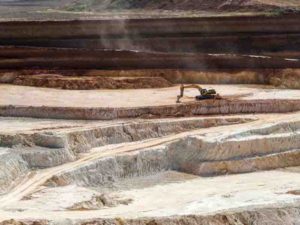
The high-density minerals in the Georgia kaolin mines are potential sources of rare-earth elements, including the heavy rare-earth elements that are in high demand for many important uses and are mostly imported to the United States from China, according to a study led by Georgia State University and Thiele Kaolin Co.
Rare-earth elements are used to make critical products, including magnetic resonance imaging (MRI) contrast agents, X-ray intensifying screens, portable X-ray machines, medical lasers, fiber optics, optical lenses, pressure sensors, monitors and television screens, fluorescent lamps, rechargeable battery electrodes and permanent magnets.
There are 17 rare-earth elements, which include the 15 elements of the lanthanide series (atomic numbers 57 to 71 on the periodic table), plus scandium (Sc) and yttrium (Y). The heavy rare-earth elements are from gadolinium (Gd) to lutetium (Lu), atomic numbers 64 to 71 on the periodic table.
Thiele Kaolin Co. mined for kaolin in two quarries near Sandersville, Ga., and provided Georgia State researchers with the leftover mineral samples, or grit, for analysis. The minerals present were identified using X-ray diffraction, scanning electron microscopy and chemical analysis. The findings, published in the journal Clays and Clay Minerals, suggest a new, potential source of rare-earth elements, including the less common heavy rare-earth elements.
“We were interested in looking at the very course, sand-sized material from the kaolin ore that they call grit. It accounts for about 10 percent of the mined material and is removed before they make finished kaolin products for a variety of applications, such as paper, paints, adhesives, plastics, ceramics, etc.,” said Dr. W. Crawford Elliott, senior author of the study and associate professor in the Department of Geosciences at Georgia State. “They gave us samples of the grit. When we processed these samples, we found a particular enrichment in the heavy rare-earth elements, gadolinium through lutetium. An enrichment in the heavy rare-earth elements is interesting and useful because in most cases, the Earth’s crust is enriched in the lighter rare-earth elements. The heavy rare-earth elements tend to be more technologically important.
“After we did a heavy liquid separation on that material, we found the Buffalo Creek Kaolin Member is about 100 times more enriched in the heavy rare-earth elements relative to concentrations in upper continental crust. Our work suggests a way to obtain heavy rare-earth elements from kaolin ore, which hasn’t been done before. This constitutes a new resource for the rare-earth elements, which we are getting all from China.”
Note: The above post is reprinted from materials provided by Georgia State University.










